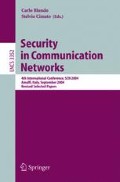Abstract
We propose a new group signature scheme that simultaneously provides the following two properties : (1) the membership authority is able to add a user but not to identify an actual signer, while the tracing authority is able to identify the actual signer but not to add a user, (2) for further decentralization, these two authorities are respectively distributed among multiple entities in a manner efficient enough for practical applications. Previous group signature schemes have only offered one or the other of these two properties. Further, we formalize the security properties.
Access this chapter
Tax calculation will be finalised at checkout
Purchases are for personal use only
Preview
Unable to display preview. Download preview PDF.
References
Ateniese, G., Camenisch, J., Joye, M., Tsudik, G.: A Practical and Provable Secure Coalition-Resistant Group Signature Scheme. In: Bellare, M. (ed.) CRYPTO 2000. LNCS, vol. 1880, pp. 255–270. Springer, Heidelberg (2000)
Ateniese, G., de Medeiros, B.: Efficient Group Signatures without Trapdoors. In: Laih, C.-S. (ed.) ASIACRYPT 2003. LNCS, vol. 2894, pp. 246–268. Springer, Heidelberg (2003)
Ateniese, G., de Medeiros, B.: A Provably Secure Nyberg-Rueppel Signature Variant with Applications. In: Cryptology ePrint Archive, Report 2004/093 (2004)
Bellare, M., Micciancio, D., Warinschi, B.: Foundations of Group Signatures: Formal Definitions, Simplified Requirements, and a Construction Based on General Assumptions. In: Biham, E. (ed.) EUROCRYPT 2003. LNCS, vol. 2656, pp. 614–629. Springer, Heidelberg (2003)
Boudot, F.: Efficient Proofs that a Committed Number Lies in an Interval. In: Preneel, B. (ed.) EUROCRYPT 2000. LNCS, vol. 1807, pp. 431–444. Springer, Heidelberg (2000)
Camenisch, J., Michels, M.: A group signature scheme based on an RSA-variant. Technical Report RS-98-27, BRICS, University of Aarhus (November 1998), An earlier version appears in ASIACRYPT 1998
Camenisch, J.L., Stadler, M.A.: Efficient Group Signature Schemes for Large Groups. In: Kaliski Jr., B.S. (ed.) CRYPTO 1997. LNCS, vol. 1294, pp. 410–424. Springer, Heidelberg (1997)
Chaum, D., van Heyst, E.: Group Signatures. In: Davies, D.W. (ed.) EUROCRYPT 1991. LNCS, vol. 547, pp. 257–265. Springer, Heidelberg (1991)
Fiat, A., Shamir, A.: How to Prove Yourself: Practical Solution to Identification And Signature Problems. In: Odlyzko, A.M. (ed.) CRYPTO 1986. LNCS, vol. 263, pp. 186–194. Springer, Heidelberg (1987)
Kiayias, A., Tsiounis, Y., Yung, M.: Traceable Signatures. In: Cachin, C., Camenisch, J.L. (eds.) EUROCRYPT 2004. LNCS, vol. 3027, pp. 571–589. Springer, Heidelberg (2004)
Kilian, J., Petrank, E.: Identity Escrow. In: Krawczyk, H. (ed.) CRYPTO 1998. LNCS, vol. 1462, pp. 169–185. Springer, Heidelberg (1998)
Miyaji, A., Umeda, K.: A Fully-Functional Group Signature Scheme over Only Known-Order Group. In: Jakobsson, M., Yung, M., Zhou, J. (eds.) ACNS 2004. LNCS, vol. 3089, pp. 164–179. Springer, Heidelberg (2004)
Nyberg, K., Rueppel, R.A.: Message Recovery for Signature Schemes Based on the Discrete Logarithm Problem. In: De Santis, A. (ed.) EUROCRYPT 1994. LNCS, vol. 950, pp. 182–193. Springer, Heidelberg (1994)
Okamoto, T.: An Efficient Divisible Electronic Cash Scheme. In: Coppersmith, D. (ed.) CRYPTO 1995. LNCS, vol. 963, pp. 438–451. Springer, Heidelberg (1995)
Pedersen, T.: A Threshold Cryptosystem without a Trusted Party. In: Davies, D.W. (ed.) EUROCRYPT 1991. LNCS, vol. 547, pp. 522–526. Springer, Heidelberg (1991)
Schnorr, C.P., Jakobsson, M.: Security of Signed ElGamal Encryption. In: Okamoto, T. (ed.) ASIACRYPT 2000. LNCS, vol. 1976, pp. 73–89. Springer, Heidelberg (2000)
Stadler, M.: Publicly Verifiable Secret Sharing. In: Maurer, U.M. (ed.) EUROCRYPT 1996. LNCS, vol. 1070, pp. 190–199. Springer, Heidelberg (1996)
Author information
Authors and Affiliations
Editor information
Editors and Affiliations
Rights and permissions
Copyright information
© 2005 Springer-Verlag Berlin Heidelberg
About this paper
Cite this paper
Furukawa, J., Yonezawa, S. (2005). Group Signatures with Separate and Distributed Authorities. In: Blundo, C., Cimato, S. (eds) Security in Communication Networks. SCN 2004. Lecture Notes in Computer Science, vol 3352. Springer, Berlin, Heidelberg. https://doi.org/10.1007/978-3-540-30598-9_6
Download citation
DOI: https://doi.org/10.1007/978-3-540-30598-9_6
Publisher Name: Springer, Berlin, Heidelberg
Print ISBN: 978-3-540-24301-4
Online ISBN: 978-3-540-30598-9
eBook Packages: Computer ScienceComputer Science (R0)

